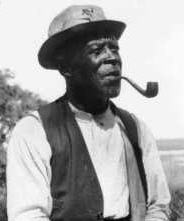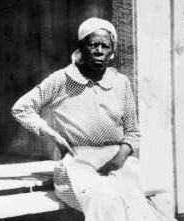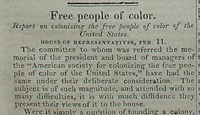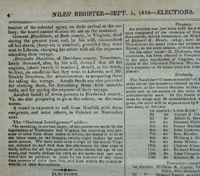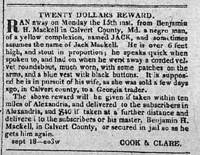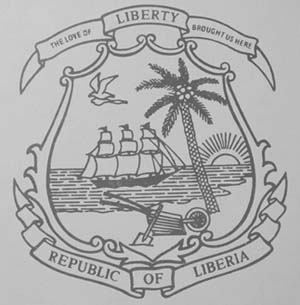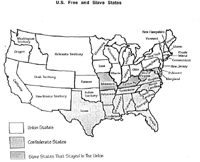|
Why Back To Africa? And |
|||||||||||
|
|
||||||||||||
|
Between 1794 and 1808 the US Congress passed several Acts with respect
to American involvement in the international slave trade. Some of these
Acts prohibited American citizens from engaging in this trade, others
outlawed the importation of new slaves. For several reasons, however,
slavery on American soil was only abolished after the civil war, in
1865. As from the beginning of the 19th century, white Americans in various parts of the country started creating colonization societies. These societies encouraged and financed the re-settlement of freed slaves and of colored people in the continent of their black ancestors who had forcibly been shipped across the Atlantic. The first society that was created was the American Colonization Society, organized in December 1816 to resettle free black Americans in West Africa. The creation of many more colonization societies would soon follow, not in the least because of the apparent success of the enterprise – despite its many difficulties and large number of casualties. Notably among the other societies were the Indiana Colonization Society, the Ohio Colonization Society, the Colonization Society of New York, the Young Men’s Colonization Society of Pennsylvania, the Kentucky Colonization Society, the Maryland Colonization Society, and the Mississippi Colonization Society.
The motives behind these efforts were often far from philanthropic.
Personal political ends, racial discrimination, feelings of fear and/or
embarrassment towards a (growing) minority of freed slaves and of
“persons of color” (the off-spring of interracial relations) were
combined with liberal, humanitarian and religious ideals.
Why Back To Africa? In the US Congress, many discussions were held before the American Government decided to financially support the ‘back-to-Africa’ operation. Reports of these discussions confirm the various motivations behind the colonization scheme, like e.g. the ‘Report on colonizing the free people of color of the United States, of the House of Representatives, dated February 11, 1817. The report was published in the ‘Niles Weekly Register’ of Saturday, April 12, 1817.
Various representatives argued that the colonization of ‘free people of
color’ had a distinct character and was different from the continuous
extension of settlements, territories and ‘colonies’ by the white
immigrant population that laid the foundation for the USA’s territorial
growth and expansion. The report reads:
“Hence, it seems manifest that these people cannot be colonized within
the limits of the United Sates. If they were not far distant, the
rapidly extending settlements of our white inhabitants would soon reach
them; and the evil now felt would be renewed; probably with aggregated
mischief.
Where the colony to be remote, it must be planted on lands now owned and
occupied by the native tribes of the country (meant are the Indian
tribes of the USA – note of FVDK). And could a territory be purchased,
the transportation of the colonists thither, would be vastly expensive,
their subsistence for a time difficult, and a body of troops would be
required for their protection. And after all, should these difficulties
be overcome, the original evil would at length recur, by the extension
of our white population. In the mean time, should the colony so increase
as to become a nation, it is not difficult to foresee the quarrels and
destructive wars which would ensue, especially if the slavery of people
of color should continue, and accompany the whites in their migrations.
Turning our eyes from our own country, no other, adapted to our colony
in contemplation, presented itself to our view, nearer than Africa, the
native land of Negroes; and probably that is the only country on the
globe to which it would be practicable to transfer our own people of
color with safety, and advantage to themselves and the civilized world.
It is the country which, in the order of Providence, seems to have been
appropriated to that distinct family of mankind. And while it presents
the fittest asylum for the free people of color, it opens a wide field
for the improvements in civilization, morals and religion, which the
humane and enlightened memorialists have conceived it possible, in
process of time, to spread over that great continent.”
The rest of the 1817 report deals with the question how to implement
these plans to ‘transfer these people of color’. In particular, the
question was raised whether to join the British in her colony of Sierra
Leone or to establish a new colony on the coast of West Africa.
Interestingly, the future independence of these colonies was already
foreseen (see picture).
In 1819 the US Government appropriated $ 100,000 to aid African
colonization. Indeed, the first attempts to settle American people of
color on the west coast of Africa concerned the colony of Sierra Leone
in 1820 and 1821. Both attempts failed. The first successful landing of
free American blacks and emancipated slaves took place at Cape Mesurado
in 1822 where a few years later the American Colonization Society
created the American
Colony of Liberia.
How voluntary was the return to Africa?
Various sources mention the sometimes far from altruistic motivations
which led to the creation of the various colonization societies (e.g.
Huberich, van der Kraaij). Mississippi journalist and bestselling author
Alan Huffman wrote the captivating story, ‘Mississippi in Africa: The
Saga of the Slaves of Prospect Hill Plantation’, based on historic facts. When in 1836 the founder of Prospect Hill Plantation, in the State of Mississippi, and slave-owner Isaac Ross died, he stipulated in his will that the plantation should be sold and the proceeds used to finance the transport and installation of his approximately 200 slaves to the west coast of Africa, to the Colony of Liberia. His shocked heirs contested Ross’ will and a long court battle followed. In the end, his will was honored and around 1849 the former slaves were shipped to Liberia. Obviously, it was Ross’ wish to have his former slaves shipped to Liberia and the latter had no say in his decision. It can be doubted whether they opted for this choice - emigration - of their own free will. For slavery still existed in the South and a continued stay in the USA would have meant a continued life as a slave.
There were more slave-owners like Isaac Ross who freed their slaves in
their last will. In a large number of cases their former slaves’ freedom
was linked to their ‘transfer back to Africa’. This was e.g. the case of
General Blackburn, of Bath county,Virginia, who died in 1835. By his
will, General Blackburn manumitted all his 46 slaves, provided they were
sent to Liberia, charging his estate with all the expenses for their
trip.
Another example is Alexander Donelson, of Davidson county, Tennessee who
also died in 1835. Alexander Donelson’s will also stipulated that all
his 26 slaves should be freed, on condition that they went to Liberia.
Finally, the Niles’ Weekly Register of September 5, 1835, which reported
the previous two cases, also mention a family of seven persons in
Frederick country, Virginia, preparing to travel to the colony of
Liberia, in the same terms.
These
are just a few examples to illustrate the involuntary background or
character of the ‘decision’ of a certain number of American black
colonists who made the trip ‘back to Africa’ and settled in the American
colony of Liberia. For it should also
not
be forgotten that
until 1865 slavery in the United States was legal, that until that year
slaves were sold from one ‘owner’ to another and that runaway slaves
were chased, and when re-captured, punished. So, after all, how
voluntary could the decision to emigrate be?
Reading these old newspapers, it is difficult not to think of the
Liberian seal and the national motto: THE LOVE OF LIBERTY BROUGHT US
HERE. The history of the founding of Liberia contains many
contradictions. This seems to be one of them.
Sources:
Huberich, Charles Henri, ‘The Political and Legislative History of
Liberia – a documentary history of the constitutions, laws and treaties
of Liberia from the earlier settlements to the establshment of the
republic, a sketch of the activities of the American Colonization
Society, a commentary on the Constitution of the republic and a survey
of the political and social legislation from 1847 to 1944’ with
appendices containing the laws of the Colony of Liberia, 1820-1839, and
Acts of the Governor and Council, 1839-1847, two volumes (New York,
1947).
Kraaij, van der, Fred, ‘The Open Door Policy of Liberia - An Economic
History of Modern Liberia’, 2 volumes, 703 pp. (Bremen, 1983).
National Intelligencer, Washington DC, September 19, 1821.
Niles’ Weekly Register, No. 7, Vol XII, Baltimore, Saturday, April 12,
1817.
Niles’ Weekly Register, No 1, Vol. XIII, Baltimore, September 5, 1835.
|
Amendment XIII
African-American Repatriates To Liberia,
1820 - 1904
Roll of Emigrants that have been sent to the colony of
Liberia, Western Africa, by the American Colonization Society
and its auxiliaries, to September, 1843, &c.
|
|||||||||||
| © fpm van der kraaij | ||||||||||||
